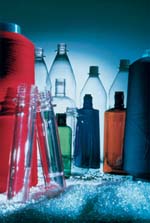How to prevent the creation of packaging waste?
The best solution aims to intervene as early as possible, that is to say during the production of the product!

Here are some ideas and examples that manufacturers can follow to limit the impact of packaging on the environment. We have divided these preventive acts into 2 categories: quantitative and qualitative.
Quantitative prevention.

- Abandon unnecessary over-packaging.
- Research new methods or techniques that reduce the amount of material essential to an efficient package.
Example: by reducing the thickness of the plastic film of the six-bottle pack from 75µm to 65µm, the “Chaudfontaine” * sources save 4 tonnes of plastic per year. - Increase portions.
Example: Lidl water bottles have gone from 1,5 l to 2 l and have saved 15% packaging per liter sold. - Optimizing grouping and transport packaging.
Example: The racks for 50 cl "Spa" * water glass bottles have been modified and now contain 18 bottles instead of 12, ie 64% more product per pallet (and as much less transport).
Qualitative prevention.

- Reducing the number of materials.
Until 1995, 1,5 l pet Coca-Cola * bottles were reinforced with a pdhd foot because the internal pressure prevented them from standing. Today, this shell has disappeared thanks to the new shape of the foot, in "petals". Not only did this change reduce the weight of the bottles and simplify production, but it also facilitates recycling because (once the cap is removed) the bottle is made of a single material. - Select materials for recycling.
Many labels on pet bottles are no longer made of paper but of opp (oriented polypropylene). Although it may seem paradoxical, these labels can be a gain for the environment. Indeed, the glued paper is difficult to separate from its support. It leads to more operations and can alter the quality of the recycled pet if there are too many impurities. The opp is easily separated from the bottle and will be recycled with the caps. It therefore facilitates recycling and stabilizes the quality of recycled pet. But for that to happen, the bottle must be recycled ... - Promote reusable packaging.
The deposit is an interesting system but it has its limits. It requires the establishment of a recovery and transport network to the plant. This is why it is perfect in the case of products distributed locally, but it is less ecological on a large scale. - Foster refills.
Unfortunately we found that consumers are reluctant to increasingly buy refills and prefer complete packages. - Take into account the energy cost.
The production of the new bottle of Ace Delicate * requires 14% less energy than the previous one.
* These products and brands are cited as an example because the data is available. They are in no way presented as unsurpassed benchmarks in environmental matters.
Read more: Preventing packaging by consumers
More:
- Our forums
- What are packages?
- Recycling techniques
Downloads
- “To be or not to be excited. 32 questions we ask ourselves about packaging ”, 1.2 Mo, published by the National Packaging Council, the CNE
- "Useful and unnecessary packaging" published by Agir pour l'environnement, cniid and France Nature Environnement

